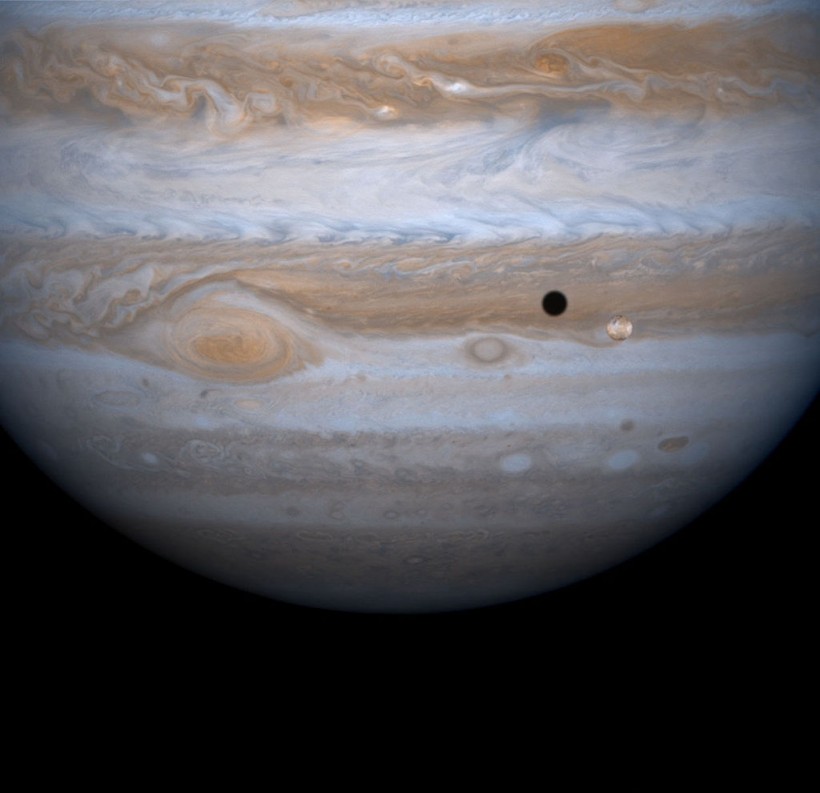A new study shows that giant cyclones in Jupiter are created by the same powers that move water in Earth's seas.
Jupiter's massive polar cyclones, which may be up to 620 miles (1,000 kilometers) broad, were first discovered by NASA's Juno spacecraft in 2016.
Since then, scientists have believed that these storms are caused by convection, the process by which hotter air expands and rises to higher, colder, and denser altitudes, as seen on Earth. They haven't been able to verify the existence of this mechanism on Jupiter until now.
Researchers published their study, "Moist Convection Drives an Upscale Energy Transfer at Jovian High Latitudes," in the journal Nature Physics.

383787 01: The entire body of Moon-sized Io, as it casts a black shadow, is captured here alongside the planet Jupiter in this picture taken by NASA's Cassini spacecraft, December 3, 2000. Jupiter's other moon, Ganymede is larger than the planets Mercury and Pluto and Saturn's largest moon, Titan. Both Ganymede and Titan have greater surface area than the entire Eurasian continent on our planet. Cassini was 26.5 million kilometers (16.5 million miles) from Ganymede when this image was taken. The smallest visible features are about 160 kilometers (about 100 miles) across.
Moist Convention Causing Jupiter's Cyclone
Wired said Jupiter, Milky Way's 4-octillion-pound elephant, creates massive cyclones, large storms that spin around low-pressure zones. Some are thousands of miles wide-as big as the United States-and have wind gusts of up to 250 miles per hour.
The planet's north pole has eight of the biggest, while the southern pole has five. For years, scientists have hypothesized about their origins. Lead author Lia Siegelman, an oceanographer and Scripps postdoctoral researcher, chose to pursue the subject after noting parallels between the cyclones and the ocean vortices she researched as a Ph.D. student.
Siegelman and her colleagues used photos from NASA's Juno spacecraft, Times of San Diego said. Geophysical fluid dynamics concepts support a long-held idea that these cyclones are driven by a mechanism comparable to moist convection, in which hotter, less dense air rises.
ALSO READ: Did NASA Juno Spacecraft Just Hear Jupiter 's Moon? Here's What Happened!
"When I saw the richness of the turbulence around the Jovian cyclones with all the filaments and smaller eddies, it reminded me of the turbulence you see in the ocean around eddies," Siegelman said in a statement.
Earth's Oceanography Linked to Jupiter's Flowing Cyclones?
Siegelman and her colleagues looked at a series of infrared photographs of the cyclones orbiting Jupiter's north pole. Infrared wavelengths tell how much heat an item emits. The researchers utilized the same approach that scientists use to investigate large-scale air and water fluxes in the Earth's atmosphere and seas.
The team was able to compute the direction and speed of local winds as well as the flow of the clouds. The researchers were able to distinguish between locations with little cloud cover, which allowed them to look further into Jupiter's atmosphere, and areas shrouded by a dense layer of fog.
Space.com said rising hot air moves energy within the atmosphere and feeds clouds as they build into large-scale cyclones, such as those seen around the poles.
For example, the physical process at work on Jupiter might disclose paths of energy exchange that scientists have yet to discover on our planet.
Beyond the physics of Jupiter's massive cyclones, Siegelman feels there is another lesson to be learned: climate and weather explorations on Earth and on other worlds appear to be two sides of the same coin.
Previous probes, such as the Galileo mission in the 1990s, investigated Jupiter by orbiting around its equator. Juno is the first spacecraft to image Jupiter's poles. The Juno spacecraft discovered eight cyclones near the planet's north pole and five near its south pole, all of which are still active more than five years later.
RELATED ARTICLE: NASA Juno Spacecraft Shares a Stunning Photo of Jupiter Making 'Mocha Swirls' On Its Atmosphere
Check out more news and information on Space in Science Times.














